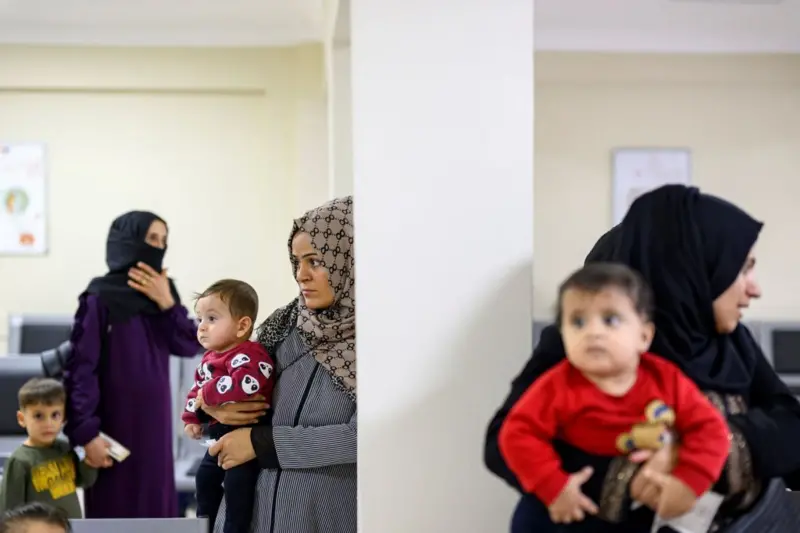According to the latest figures of the Migration Administration, the number of Syrian children aged 0-4 in Turkey is 408,164. The number of Syrian children aged 5-9 is 528,560. Birth rates among Syrian refugees living in urban areas, who have recovered from the effects of the war, will continue to fall faster than those of Turkish citizens. In 2021, the number of Syrian refugees under temporary protection in Turkey peaked at 3.7 million. Since then, this number has fallen to 3.1 million, with those leaving for Europe and those returning to Syria. At that time, Syrian refugees made up about 4.6 per cent of Turkey’s population. Even if all Syrian refugees stayed in Turkey and no one returned to Syria or went elsewhere, Syrians would not even make up 6 per cent of Turkey’s population in the future.
Many racists in Turkey have long argued that Turkish demographics are changing, citing the ‘silent invasion’ argument. They have even suggested that Syrians in Turkey may constitute the majority of the population. Unfortunately, the Turkish government does not provide precise figures and calculations for the future as Syrians are under temporary protection. However, the latest data shows that even if all Syrian refugees stayed in Turkey and no one returned to Syria or travelled elsewhere, Syrians would not even make up 6% of Turkey’s population. Now, let’s take a closer look at the figures.
According to President Erdoğan’s recent statements, the birth rate per woman in Turkey has fallen to 1.51. In 2018, Turkey reached a rate of 2.0, which was the first time it had fallen below the reproductive rate. Since then, this downward trend has continued. Between 2014 and 2018, 6,535,141 children were born, while between 2019 and 2023 this number dropped to 5,370,556, a 17.82 per cent decline between the five-year periods.
However, the figures published by the Turkish Statistical Institute do not include Syrian refugees. Although the Turkish Statistical Institute publishes annual figures, the same organisation does not directly publish figures on the number of births of Syrian asylum seekers.
However, the Turkish Directorate of Migration Management regularly publishes the number of Syrian asylum seekers in Turkey. I looked at the figures published on 18 April 2024. The number of Syrian children aged 0-4 years is 408,164. The number of Syrian children aged 5-9 years is 528,560.
Despite the high decline in birth rates among Turks, the rate of decline among Syrian refugees is much higher. In reality, this is quite understandable and expected. In the coming period, the rate of decline among Syrians will continue to be higher than among Turks. There are some psychological characteristics that people show everywhere and at all times. One of them is the correlation between war and birth rate.
Whenever and wherever there is war, people dramatically increase their birth rates. The same has been true for Syrians. Based on Syrian refugees in Turkey, the number of children in Turkey jumped from 360,670 11-14 years ago to 528,560 5-9 years ago. Now, as the demographic impact of the war diminishes, Syrians are more and more leaving the psychological effects of the war behind.
Second, Syrians in Turkey live almost entirely in cities. 98.15 per cent of all Syrian refugees live in urban areas. Compared to rural life, urban life is not favourable for high birth rates. The effects of urbanisation on birth rates apply worldwide and also for Syrians. Unlike Syrians, the rate of decline of the birth rate of Turks living in rural areas is smoother.
Finally, Syrian asylum seekers are adapting to living conditions in Turkey. Despite the lack of state policies, Syrian asylum seekers are integrating into Turkish society. With each passing day, the birth rate of Syrian refugees in Turkey will become the same as that of Turkish citizens. The same thing happened with Turks in Germany.
| Year | Birth numbers (Excluding Syrian migrants) | Birth number of Syrian migrants | Total birth number | Syrian migrant birth rate |
| 2014 | 1,345,286 | 528,560 | 7,063,701 | 7,48% |
| 2015 | 1,333,329 | |||
| 2016 | 1,311,895 | |||
| 2017 | 1,295,784 | |||
| 2018 | 1,248,847 | |||
| 2019 | 1,183,652 | 408,164 | 5,778,720 | 7,01% |
| 2020 | 1,112,859 | |||
| 2021 | 1,079,842 | |||
| 2022 | 1,035,795 | |||
| 2023 | 958,408 | |||
| Total | 11,905,697 | 936,724 | 12,842,421 | 7,29% |
Future Demographic Projection
When we look at the number of Syrian children and Turkish children in Turkey in the last decade, Syrian children constitute 7.29 per cent of the total. However, the number of Syrian children fell from 7.48 per cent in the first five years to 7.01 per cent in the last five years. As noted above, birth rates among Syrian refugees will continue to fall faster than among Turkish citizens. At some point, birth rates among Turks and Syrians in Turkey will become similar, so the percentage of Syrians in Turkey will reach a tipping point.
What if there is no new large migration movement in Turkey and all Syrian refugees stay in Turkey?
Within these imaginary limits, if all Syrian asylum seekers remain in Turkey, the total number of Syrian asylum seekers in Turkey’s future will remain below 6 per cent.
Currently, the percentage of Syrian refugees in the Turkish population is 3.52 per cent and the birth rate among Syrians is falling much faster than among Turks.
Even if we take into account the 146,424 Syrians with residence permits in Turkey and the 237,995 Syrians with Turkish citizenship, the total percentage would not reach 6 per cent – even if all Syrians remained in Turkey.
However, even this assumption is incorrect. The number of Syrian refugees in Turkey has decreased, not increased, over the last 3 years. In 2021, the number of Syrian refugees in Turkey under temporary protection peaked at 3.7 million. Since then, this number has fallen to 3.1 million. At that time, Syrian asylum seekers made up around 4.6 per cent of Turkey’s population. Now it is 3.52 per cent. A projection three years ago would have shown us a different and higher result than it does now.
The decrease in the number of Syrian asylum seekers in Turkey by around 600,000, despite new births, is due to two main reasons. The main reason for this decrease is the cancellation of the registration of Syrian asylum seekers going to Europe. As it is known, more than 1 million Syrians fled from Turkey to Europe and applied for asylum.
The second reason for this decrease is the return to Syria. According to the Ministry of Interior, at least 562,000 Syrians returned to Syria until June 2023. In the 16 months since then, more than 100,000 more Syrians have returned as part of ‘voluntary return’, according to data published at border crossings.
The return of Syrians to Syria will not include the majority of Syrians in Turkey, but the process of ‘voluntary return’ and ‘deportation’ is likely to continue. It is not possible to clearly assess how many Syrians will remain in Turkey and how many will return to Syria or go elsewhere, it can only be estimated. Therefore, it is up to the individual to predict what the future demographics of Turkey will look like and what the percentage of Syrians will be. However, one thing is clear at the moment: this estimate should remain below 6 per cent.
The Silent Invasion Lie Imported from Racists in Europe
In order to make the above predictions more realistic, the concept of ‘silent invasion’ should also be discussed. In fact, this concept, which has been invented by racists in Turkey and which has attracted a great deal of attention, is not a newly invented issue. It is a concept copied from the enemies of Turks and Muslims in Europe and adapted to Turkey, as racists in Turkey almost always do. I don’t know about other European countries, but the concept of ‘silent invasion’ became very popular in Germany in 2009. At that time, millions of people watched this kind of content and there were arguments that Europe was being silently Islamised and that Muslims in Europe would form the majority of Europe with their birth rate.
While the racists in Turkey copy from Europe, they do not update themselves due to their poor quality and resort to arguments and discourses that have been refuted and are outdated. The low-quality animated video ‘Die Islamisierung des Abendlandes’, which made the concept of ‘silent invasion’ famous in Germany, was published in 2009. Thanks to the 15 years that have passed, we can now clearly see how wrong the predictions made in the video were. Namely:
In the video published in 2009, it was claimed that 50 per cent of the population of the Netherlands would be Muslim in 2024. This ‘prediction’, based on the birth rates of Muslims and Dutch people in the Netherlands, had nothing to do with reality. Today only 6 per cent of the Dutch population is Muslim. In the video, it was predicted that Belgium would be 33 per cent Muslim in 2025. Today, the Muslim rate in Belgium is 5 per cent. The video claimed that France would be 20 per cent Muslim in 2027. In the intervening 15 years, the Muslim population in France has become 10 per cent. For Russia, it was calculated that Russia would become 40 per cent Muslim in ‘a few years’. However, despite the 15 years that have passed, the Muslim population in Russia has become 18 per cent. Finally, for Germany, it was claimed that Germany would become an Islamic country in 2050, again based on birth rates. In the intervening 15 years, the Muslim population has only risen to 6.5 per cent.
| Country | Forecast Year | Forecast Rate | Current Real Rate |
| Netherlands | 2024 | %50 | %6 |
| Belgium | 2025 | %33 | %5 |
| France | 2027 | %20 | %10 |
| Russia | 2014 – 2018 | %40 | %18 |
| Germany | 2050 | Majority | %6,5 |
In short, it is very difficult to calculate the ratio of an ethnic or religious minority or immigrant group to the future population. It is a grave mistake to base a calculation on the current birth rate of a group. These approaches, which ignore human nature, have only one purpose: To scare people. By scaring people, they aim to prevent people from thinking and discussing an issue in a healthy way.
As a result of the lessons learnt from their racist teachers in Europe, the racists in Turkey scare the Turkish people with lies and prevent a healthy discussion of the Syrian asylum seekers in Turkey and the general migration issue. Where to address the issue of Syrian asylum seekers in Turkey and the future of this issue as a mass that would not be 6% even if they all stayed in Turkey, where to address it by saying that we are facing a ‘silent invasion’.
Auto translated from serbestiyet.com






